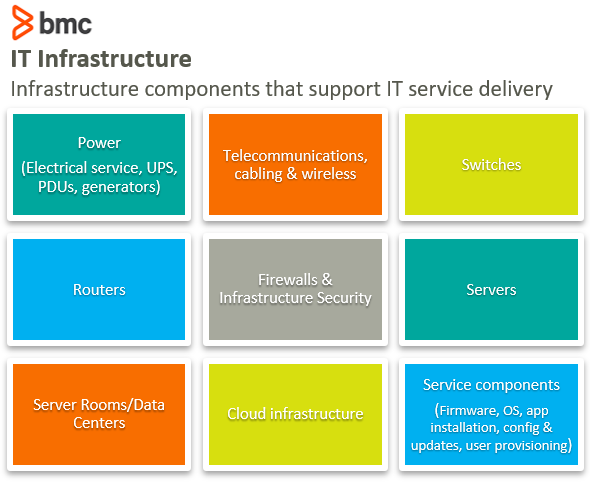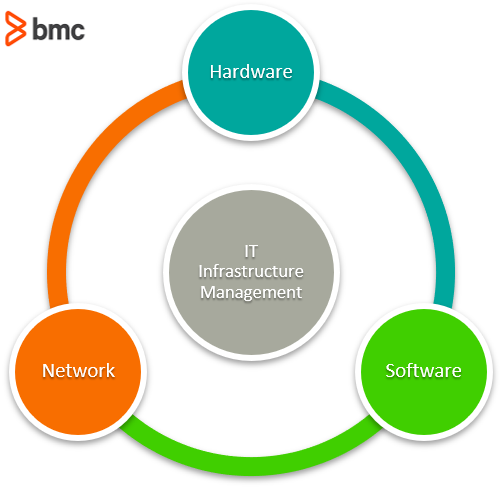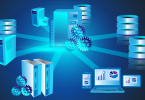What is IT infrastructure and how do you manage it? Gartner defines IT infrastructure this way:
IT infrastructure is the system of hardware, software, facilities, and service components that support the delivery of business systems and IT-enabled processes.
Let’s tackle the broad topic of what IT infrastructure is, what it includes, and who manages it. Then, stick around for the end. We’ll play a game that puts your IT infrastructure knowledge to the test!
(If you’re looking for how-to’s and tips, see IT Infrastructure Planning: How To Get Started.)
IT infrastructure is a road
The Gartner definition is good for dealing with IT people. However, when discussing IT infrastructure with organizational management, HR, or the C-suite, I generally use this road metaphor:
IT infrastructure is the digital road your information travels on.
Like building a physical road, infrastructure professionals plan, build, maintain, fix, and secure their own digital road, over which all organizational data travels. They do not load and unload the informational vehicles riding that road; they create the pathway the vehicles run on, maintain the road, and regulate access and behavior on their infrastructure road.
All of which ensures the requested information gets to its intended user or app—be it terminal screens, in-house applications, web sites, mobile apps, time punches, spreadsheets, documents, reports, emails, or anything else.
Like local authorities, IT infrastructure managers manage their own individual piece of the road and its access to the internet. Non-IT people may be fuzzy about hardware and IT-enabled processes, but they know exactly what a road is. That is why the road metaphor works.
What belongs to IT infrastructure?
Here is a picture of the components that (IMHO) make up an IT infrastructure.

What’s not included in IT infrastructure?
IT infrastructure is notable for the things it does not include. Here is the list of things that are not usually included as IT infrastructure:
- Application development which is usually supported by application developers or a DevOps or Agile function.
- Database analysis and reporting, including Business Intelligence and Big Data, which has its own set of professionals.
- User devices, such as desktops, laptops, terminals, scanners, tablets, phones, etc. These items are usually managed by a service desk/help desk or another IT department.
- People, processes, and documentation are not traditionally considered part of IT infrastructure, even though they may play significant parts in managing that infrastructure
But note. There are a lot of grey areas. Especially when considering other IT infrastructure-adjacent professions such as Data Center Manager, Network Manager, DevOps, database administrator, Application Support, Service Desk management, etc. Many of these jobs handle functions that are considered infrastructure and cover different sub-functions of the infrastructure.
But the heart and reason for infrastructure management are the areas covered above.
Who manages IT Infrastructure?
IT Infrastructure Managers require a specific set of skills. These skillsets must be understood by any technicians, project managers, or higher-level staff (such as directors and CIOs) responsible for the infrastructure:
- The technicians must understand how to deploy and set up infrastructure components.
- The project manager needs to understand and direct infrastructure changes.
- The higher-level staff must understand the architecture, budgeting, specifications, and strategic purpose of each infrastructure function.
Specifically, anyone managing IT infrastructure uses these three system skillsets:

Hardware infrastructure management
Selecting, installing, deploying, maintaining, and configuring all the hardware in the infrastructure. Physical infrastructure hardware includes:
- Cabling
- Firewalls
- HVAC systems and fire suppression systems
- Intermediate Distribution Frames (IDFs)
- Modems
- Patch panels
- Physical security for on-premises, off-premises, and cloud data centers (keyed locks, electronic locks, mantraps)
- Power systems (UPS and generators)
- Routers
- Server racks and server hardware
- Special purpose servers for load balancing, security, Internet gateways, email filtering, etc.
- Storage devices
- Switches
- Telecommunications equipment
- Wall jacks
- Wireless access points
Hardware skills also include managing any cloud infrastructure services your organization may use, where services have migrated to the cloud. Technical skills for dealing with infrastructure hardware include:
- Installation
- Repair
- Hardware upgrades
- Operating system installs and updates
- Configurations
Going back to my analogy that your IT infrastructure is a road, the hardware infrastructure are the building blocks and components needed to build an infrastructure road.
Network infrastructure management
Network infrastructure involves all the interconnected hardware and internet components that must be configured to transport data and allow access into and out of your infrastructure. The network infrastructure organizes your hardware so that all network nodes can find and talk to each other—while keeping the bad guys out.
Once your hardware is racked, you can begin working on your network infrastructure:
- The hardware infrastructure is physically connected through cabling or wireless access points.
- Patch panels, switches, routers, firewalls, and appliances are cabled and configured for access.
- IP addresses, subnets, and gateways are created to segment your network, along with the TCP/IP services (such as DHCP and DNS) that allow traffic to move inside and outside each network segment.
- The network infrastructure is also connected to the internet and your Wide Area Network (WAN) through security servers\devices such as firewalls, edge servers, and telecommunication lines.
In the road analogy, the network infrastructure is the connected and configured set of physical devices that convey traffic along the infrastructure road.
Software infrastructure management
Infrastructure software includes all the application and utility software that runs on your on-premises and cloud servers. These skills include:
- Hypervisor (VMWare, Microsoft Hyper-V, IBM Power Hypervisor, etc.), installation, configuration, updates, and maintenance
- Server operating system install, configuration, upgrade, and maintenance (Windows, Linux, UNIX, IBM i, etc.)
- Server utility software (email, monitoring, job scheduling, FTP, Windows AD, CRM, other third-party software) installation, update, configuration, and maintenance
- On-premises and cloud backup server setup, upgrades, maintenance, and configuration
- User provisioning and security for system access, services, and some applications
These skills are applied for on-premises environments and in any Software as a Service (SaaS), Infrastructure as a Service (IaaS), or Platform as a Service (PaaS) environments you may be using in the cloud.
Infrastructure software vs business application software
Beware: Do not confuse infrastructure software with business application software.
- Infrastructure software is generally anything that enables IT processes.
- Business application software is generally anything that enables business processes.
Business apps are usually custom written or modified. (That’s in spite of vendors saying you will be able to run their apps in their delivered, vanilla configuration.) Infrastructure apps are generally purchased third-party applications that are configured by infrastructure staff.
Here are some examples of what I would consider infrastructure software versus business application software:
| Infrastructure Software | Business Application Software |
|---|---|
|
|
That said, there is also some overlap between infrastructure and business application software. Infrastructure management may configure some features in a company’s ERP system, as well as the initial software load and upgrades. In DevOps environments, infrastructure may take over some functions usually assigned to business applications. These assignments can be somewhat fluid. In most instances, the programming versus server and utility software comparisons holds up. But be aware there are some instances where this line is crossed.
In the road analogy, business, mobile, Web, and IOT applications load up requests and information into vehicles traveling on the infrastructure road. Once each vehicle’s load is delivered, it is processed, replied to, and other actions are initiated and sent out again on the infrastructure road. Much like a physical road does not load trucks, the infrastructure road does not load up informational vehicles. It just delivers and regulates how they are delivered to the intended locations (servers, devices, machines, etc.).
Is this IT infrastructure? (A game!)
To drive home the point about what is and isn’t IT infrastructure and how you manage it, let’s play a game called IS THIS IT INFRASTRUCTURE?
Here are nine questions. Tell me whether these items are IT infrastructure. Miss more than three questions and you will sink in the floor which might just be made of lava! (Or maybe not, we are still working this whole game show thing out.)
| Is this IT infrastructure? | Answer | Tell me why, Joe |
|---|---|---|
| Yes | Configuring the copier to relay email to the company email system for delivery enables an IT process. |
| No | Data reporting has nothing to do with infrastructure. These requests are usually handled by application developers, BI specialists, database analysts—but not infrastructure. |
| Yes | Server installation and upgrade is a definite IT infrastructure component. |
| Yes | A VOIP system is an IT service that does not involve application development. |
| No and Yes, but not Maybe | Trick question: App development is the province of your applications function. However, anything that involves downloading the app from the Internet, opening holes in the firewall for the app to send and receive information, and other IT infrastructure services for that app are definitely infrastructure. |
| Yes | All electrical requirements for powering your infrastructure components are definitely part of the infrastructure. Generators and other electrical requirements may also be acquired and installed in conjunction with facilities management. |
| Yes | Cloud services are definitely part of IT infrastructure. Infrastructure will probably lead this project but for the HA part to be successful, you may need help from your Applications or DevOps people (and some users) to test and verify HA is working correctly. |
| Yes | Who else is going to do this? |
| Yes, but others may also be involved | User setup is usually either an infrastructure or a Service Desk item (but the Service Desk often reports to infrastructure). User setup involves multiple configuration of infrastructure services, including Windows AD and Microsoft Azure setups, email setups, and adding the user to multiple application setups, which may or may not be tied into AD. |
How did you do? Once you get the hang of it, you can easily determine whether something falls under IT infrastructure.
Infrastructure delivers business value
Generally speaking, IT infrastructure management is anything that does not involve: application development, database analysis and reporting, and individual device deployment and management.
Remember the road. Infrastructure delivers informational output from business applications, just as a road delivers products loaded onto trucks. Infrastructure provides the delivery mechanism for business information; business applications provide the information itself.
Additional resources
For more on this topic, explore these resources:
- BMC IT Operations Blog
- Infrastructure Monitoring vs Management: What’s The Difference
- What’s Driving The Boom in On-Premises Hardware?
- Hybrid Digital Infrastructure Management (HDIM): An Introduction
- Cloud Infrastructure: A Brief Introduction
These postings are my own and do not necessarily represent BMC's position, strategies, or opinion.
See an error or have a suggestion? Please let us know by emailing [email protected].






